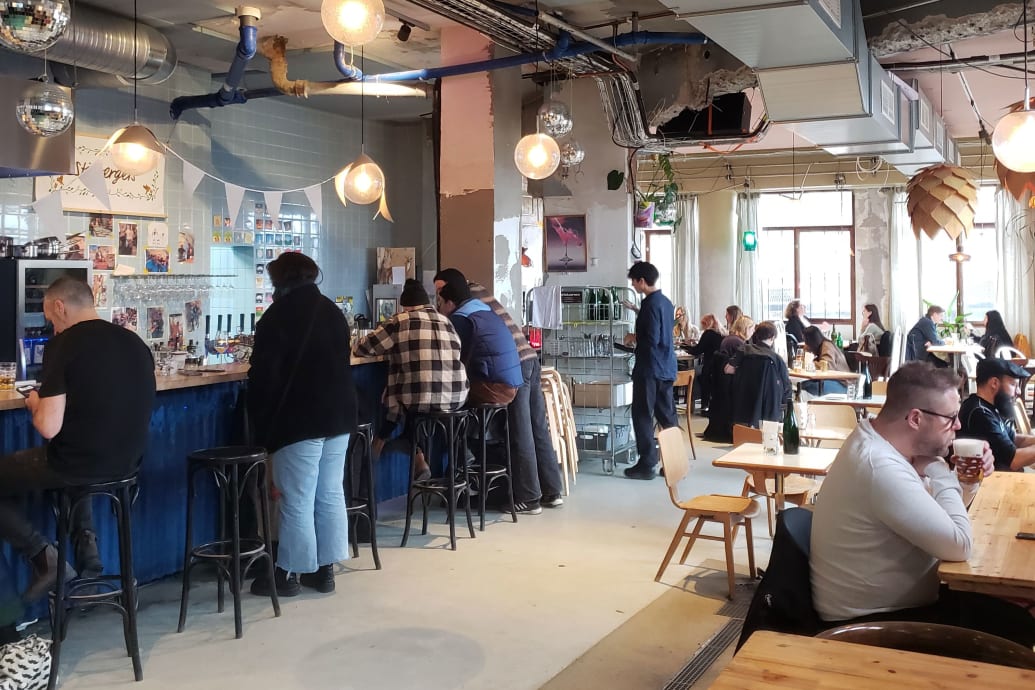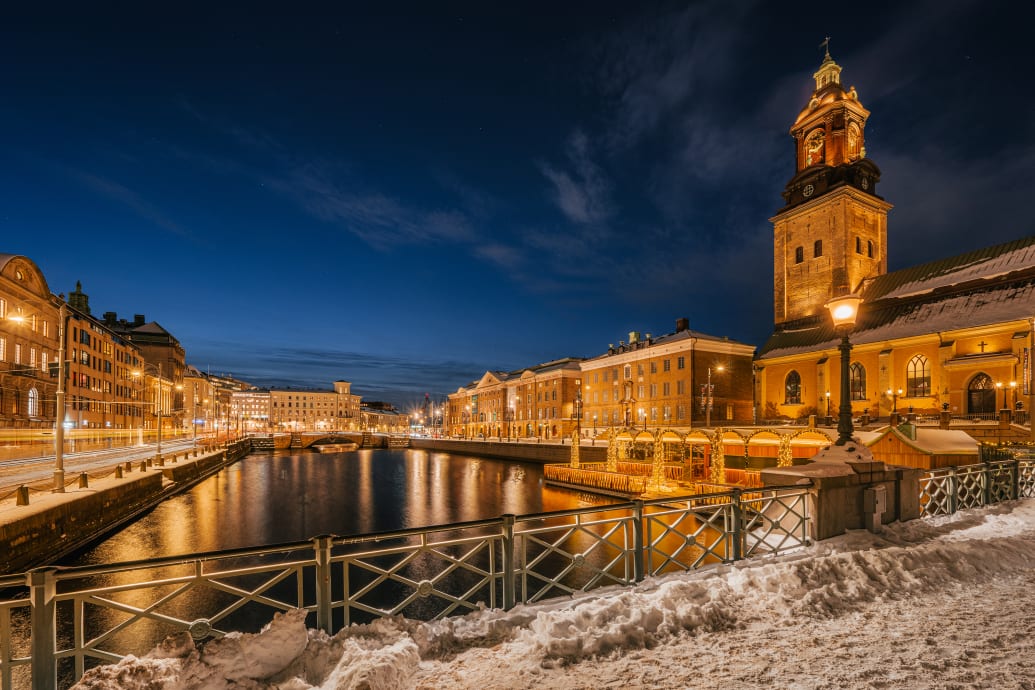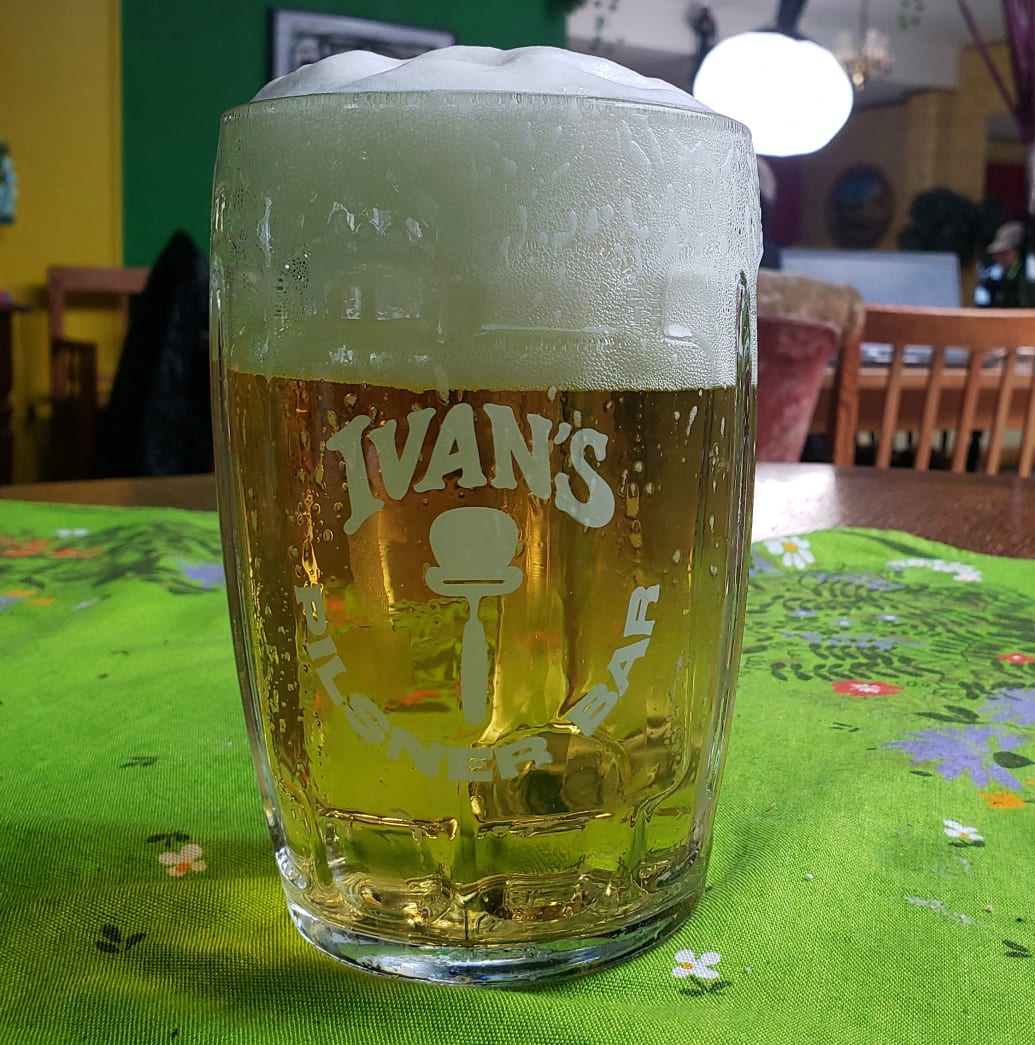The O/O Brewing tap room is on the ground floor of a nondescript brick apartment building on a main strip of Majorna, a district known for its buzzy bars and restaurants, in Gothenburg, Sweden. There are windows onto the street and a neon sign hangs over the door, but the cramped space and no-frills décor—a few wood stools at a plank of a bar, tiled walls, compact booths—do nothing to suggest the intriguing beers on tap or the impact those offerings have had.
On a Tuesday afternoon just before summer, I sat with Olof Andersson, a co-owner of O/O, who guided me through a sampling of their beers. A crisp, sessionable pilsner, hoppier than the familiar German brews, is a tribute to the history of his craft. Two versions of Narangi—a straightforward IPA and a punch-packing double IPA—place O/O firmly in the zeitgeist. And finally, barley wine—a sweet, round, British-style drink—an uncommon product for a tiny brewery, which makes it all the more remarkable.
“We make what we like to drink,” he said matter-of-factly. Because who wouldn’t.
Liza Weisstuch
Olof and his partner Olle Andersson (childhood friends, no relation) started their company in 2013 as home-brewing enthusiasts, not heavily capitalized businessmen. They made their beer at Stigbergets Bryggeri, a small brewer and trailblazer in what’s become a new wave of brewing in Gothenburg. Today Olof and Olle have their own brewery and Stigbergets, the biggest craft producer by volume, has a much larger facility. That original space now houses Shangri-La, a café-esque brewpub accented with disco balls. It’s the sweeping, airy yin to O/O’s intimate yang, where tattooed young people tap away on their MacBooks and tattooed retirees enjoy not having to be in front of a computer.
“It’s not really a beer bar, it’s an artistic café with weird food,” Stigbergets’ co-owner Nils Hultkrantz told me. For the inaugural Gothenburg Beer Week, in 2016, his brewery made a New England IPA—a hazy variety that’s more juicy than bitter—that became the first European IPA to make the top ten of the influential Ratebeer’s world’s best IPAs list. It launched a Sweden-wide NEIPA craze.

Stigbergets Shangri-La
Liza Weisstuch
Stigbergets has grown in sync with the city’s beer scene, which rivals—if not surpasses—that of major Nordic capitals, like Stockholm and Copenhagen. It’s also grown in sync with the popularity of “second cities.” As evidence of an increase in tourism here, Swiss Air launched its first direct flight from Newark to Gothenburg in April.
“Since 2016, we’ve gotten accustomed to Gothenburg being a beer town,” he said. “A lot of us have been waiting for this, it’s long just been a matter of time. Things were always happening here, but now it’s just a high level of quality everywhere you go. And it’s different from cities like Prague, where you go to get great pilsner because that’s what they’ve been known for and done well throughout history.”
Today, this city of 600,000 has 35 breweries making 45-plus brands, giving it the highest per capita number of breweries in Scandinavia. While all this sounds modern and trendy—and it certainly is—brewing in Gothenburg has deep historical roots.
The Port of Gothenburg, situated on the estuary of Göta älv, is the largest in Scandinavia. In the 18th century it was a European center of trade from China and the Far East and a hub of the shipbuilding industry. And where there are laborers, there is beer. The Gothenburg City Museum offers a glimpse of the story with its display of bottles of Carnegie Porter, which was first produced in 1817. Today it’s owned by Carlsberg, the Danish multinational, and made outside Gothenburg.

Tim Kristensson
“If you talk historical perspective, we were one of the biggest porter cities in Europe. In the early 19th century, it was Dublin, London and Gothenburg,” Fredrik Berggren, a beer writer and founder of Gothenburg Beer Week, told me. “Gothenburg was brewing 6 million liters a year. They were brewing more porter 200 years ago than all the beer craft brewers make now, put together.”
We met for lunch at Ivan’s Pilsnerbar. And by “lunch” I mean two rounds of pints. Ivan’s is in Ringön, a patchwork of warehouses and parking lots with one working shipyard. Once a bustling industrial hub, its abandoned buildings are a playground for creatives. From any given point in Ringön, Fredrik noted, there are 12 breweries within a two-kilometer radius.
Ivan’s offers traditional brews in a none-too-traditional setting—neon lights, vintage velvet chairs, a fuchsia wall here, a lime-green wall there, a stage for DJs. The kitchen has a robust menu of pasta dishes. The tagline is “Pilsners, pasta and techno.” It is accurate.

Ivan’s Pilsnerbar
Liza Weisstuch
“It’s not a nightclub. It’s a restaurant, where sometimes you can dance on the table,” said Ivan Larsson, who has an Archduke Ferdinand-style mustache, a tattoo of ripe tomatoes on a vine wending its way up his arm, and an inexplicable obsession with cheese slicers—so much so that cheese slicers top the taps fountain here. He named his son after the inventor. “We’re a bar in the middle of nowhere. We have to get people to come here. Tables should be danceable.
The wood should be soft, nice. Plus the best table to put a beer on top of is a thick wood table.”
Rasmus Herbertsson, bartender and resident beer scholar, placed a mug of extra-foamy pilsner in front of each of us at the bar. Serving a pilsner with an inch-plus of creamy foam is normal, he assured—at least in Eastern Europe. It takes years for bartenders there to learn how to pour a beer, he explained, expounding on the low-tech yet complicated phenomenon involving faucets, sieves, flow rates and bubbles.
“In the Czech Republic they say brewers brew the beer, bartenders make the beer,” Rasmus said, techno beats pulsing softly in the background. (It was only lunchtime, after all.) “In Sweden, we don’t have a culture of the old world, so we take ideas from around the world and cherry-pick the best.”
Sweden’s beer history certainly isn’t as epic as Eastern Europe’s, but that’s not to say it isn’t old. Where historic artifacts are concerned, there’s an elaborate display at Gothenburg Brewery Museum, which features antique brewing equipment, bottling lines, and photos of men making beer. It’s located in Göteborgs Nya Bryggeri, or Gothenburg’s New Brewery, a vast industrial operation at the far end of a parking lot from where a taxi dropped me off. Here is where I met Linus Pilebrand, lead brewer at Gothenburg Brew, the craft arm of Göteborgs Nya. A guitarist and singer with a few metal bands, he has dreadlocks that fall past his ribcage, the build of a quarterback and a gentle but enthusiastic demeanor.

Göteborgs Bryggerimuseum
Liza Weisstuch
He also proved to be a natural storyteller. As he showed me around the brewery and the museum and poured me a sample of Chuck the Oyster, a roasted-malt-heavy imperial stout with a slight black licorice kick, he explained the epic drama that is Big Beer in Sweden. Göteborgs Nya is the former home of Pripps, which was founded in Gothenburg’s center in 1823, but outgrew that facility and moved to this industrial plot in the 1970s. Over the decades, Linus told me, it was a power player that bought up regional breweries, but it was beaten at its own game when a bigger power player, Carlsberg, purchased it at the turn of the millennium, then shuttered it in 2003. Göteborgs Nya was founded by a handful of former Pripps employees. The craft arm evolved from that. Linus’s products have the benefit of a big company behind it, but I asked him what contributes to so many smaller brands’ successes. He paused.
“The bands here really put the city on the map with the Gothenburg Sound,” he said of the style that’s best described as melodic death metal. “Brewers are a little similar—it’s a small community and everyone knows everybody—whether you’re an owner or an employee. And everyone wants to help one another. If someone’s delivery is late and you need hops, you know you can call on others.”
That kinship comes through loud and clear at Brewers Beer Bar, which has outposts in the city center and in Magasinsgatan, an old warehouse-district-turned-hipster hangout zone, and is known for its imaginative sourdough pizzas.
“The magic bullet that makes things happen in Gothenburg—less so in Stockholm—is none of us have fans to ourselves. Everyone’s doing collabs with other breweries. Everyone’s fanbase is mixed. We’re each bigger together,” said Pelle Frost, a co-owner of Brewers and founder of All In Beerfest, which celebrates its eleventh anniversary this November. It takes its name from the brewery he also co-founded.
Pelle is an effortless and nimble host behind the bar, pulling pints and pirouetting this way and that to serve them, not missing a beat as he carries on several conversations simultaneously. It’s a little bit mesmerizing. He poured me three different IPAs and talked me through the hops in each—Citra, Galaxy Spectrum, Nelson Sauvin—as if explaining the obvious but often-taken-for-granted differences among apple varieties.
With his graciousness and an engaging manner, it’s little wonder his bar is an industry go-to. As I ate my Popeye sourdough pizza (cauliflower crème, feta, parmesan, pea sprouts, spinach, garlic dressing) on a Sunday night, Pelle waved at a man with a white goatee walking through the door. “That’s the guy you want to talk to,” he said. “We all learned what we know from him. We have the culture of collaborating because of him. And brewing culture in general, too, I think.”
Over the next two hours, Mikael Dugge Engstrom, who’s something of the Yoda of Gothenburg’s brewing community, told me about traveling the world as a marine engineer, meeting his wife Kirsti, who reads Morse code, shifting careers into e-commerce and learning about brewing accidentally in a pub from a British brewery-equipment salesman. Just for kicks, he Macgyvered some used milk tanks to make a brewing system.
“In Britain, they have a lot of small breweries, but in Sweden, we had mostly big ones. I wondered: why not us?” he said. It was 2005. The time was right.
Before 2000, the Swedish government, which has a monopoly on alcohol (government-run Systembolaget stores are the only place to buy alcohol), imposed limits on the alcohol content of beers, hamstringing brewers, as many popular craft styles are higher in proof. That limit changed when Sweden joined the EU.
Mikael and Kirsti told me to stop by his tap room, Pils, which opened during the pandemic. His son had recently taken over as CEO and the whole family would be there to celebrate his birthday the next day.
The modern bar is all tall windows, cheery bubble-letters signs and bright splashes of colors, but the vibe evokes a dim Irish country pub. Mikael and Kristi greeted me like an old friend and pointed out who was who among the extended family around the table. I went to the bar to order and without prompting, the bartender poured me a Tropic Thunder.
“Here, this is the one you want,” he guaranteed. He was right. The mango/peach/passionfruit sour, Dugges’s flagship, has a tangy, fresh snap I’m still thinking about, months later.
Over the nine days I spent in Gothenburg, I ordered pints in close to 20 establishments. I drank pilsners aged in oak, an uncommon practice, at Poppels Citybryggeri. The light-flooded brewpub is the smack-in-the-middle-of-the-city outpost of a popular brewery outside the Gothenburg. At Hönöbryggeriet, a compact waterside operation on Björnhuvudet, an island in Gothenburg’s northern archipelago. (And easily one of the prettiest, quietest places to drink.) Their American IPA is made with yeast from the local baker.

Hönöbryggeriet
Liza Weisstuch
And on a busy Saturday night at Haket, a labyrinthine tavern where I had a muscular IPA from Beerbliotek, one of the beers brewed specially for Cattis Ledius, who owns the place with her husband, Masse Flohr. It used to be her family’s luncheonette, but now it’s a buzzy nighttime destination. Cattis dashes in and out of each room all night to check on everyone. Brewers and customers alike know her as Olmamma, or “beer mother,” because of the way she looks after all the brewers. Hoket is Gothenburg’s only independent bar.
“Most people drink lagers from big breweries, but we have so much good beer from local breweries,” she said. “I’ll never stop talking about that. As long as I live, never stop talking about how important it is to support local ones.”









